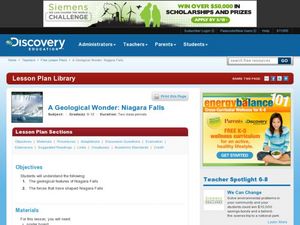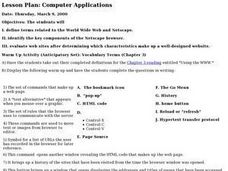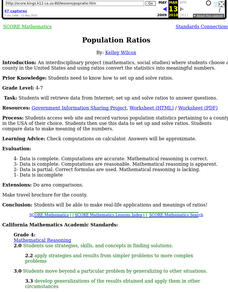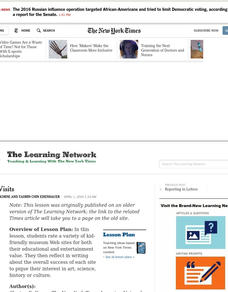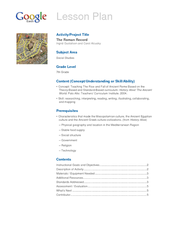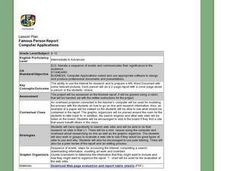Curated OER
The Euro: Money Changes Everything
Students begin the lesson plan by being introduced to the currency of the Euro. As a class, they must decide which is worth more, the euro or a United States dollar. Using the internet, they determine the current exchange rate and...
Curated OER
A Geological Wonder: Niagara Falls
Students research the geological features of Niagara Falls. For this earth science lesson, students create a poster board proposing a new website for the tourist center. They share their project in class.
Curated OER
The Fourth Quadrant of Proportiona
Students experiment with scale to solve a problem presented in a video clip. They determine the correct size to use when constructing a model and evaluate the use of proportions in real life applications.
Curated OER
Little Stories - Women in the 36th Parliament
Students develop visual literacy skills. They evaluate, organize and communicate information.
Curated OER
Should Kids Vote?
Students develop critical analysis skills important to evaluate democratic structures. They increase their knowledge of the characteristics of voters and voting impact on the Electoral System.
Curated OER
The Constitution and The Bill of Rights
Pupils explore the Constitution and The Bill of Rights including the process of the Convention throgh a variety of websites that examine the framers, venets leading up to and after the convention games and more.
Curated OER
Computer Applications - 2
Students define terms related to the World Wide Web and Netscape. They identify the key components of the Netscape browser and evaluate web sites after determining which characteristics make up a well-designed website.
Curated OER
Researching Stocks on New York Stock Exchange
Sixth graders research to find background information and stock history over the last year about a company listed on the NYSE. They evaluate whether or not they should "invest" in that company. They write a persuasive essay outlining...
Curated OER
The Bridge Challenge
Students identify important structural elements in bridges. They use a worksheet and websites to investigate different types of bridges and variable factors that relate to building a bridge.
Curated OER
The Status Of Private Schools In Utah
Students investigate the status of private schools in Utah. This done by looking at the public school system and make comparisons. The question of private schools being better is not clear and many factors need to be considered in...
Curated OER
Alternative Energy
Students identify the five major alternative energy sources. In this physical science instructional activity, students assess the advantages and disadvantages for each type of energy. They complete a concept map using information they...
Curated OER
Archeological Thinking
Sixth graders review the differences between a historian and archaeolgists. At a recent archaeological dig site, they examine the artifacts and determine their usage. In groups, they are given a bag full of artifacts and write down what...
Curated OER
Ethics and Reproductive Issues: The Dilemma of Choice
Students research various websites to answer questions and take part in class discussion regarding Prenatal testing. Students listen to an audio file and complete student worksheet. Students discuss different roles of people and...
Curated OER
The Death of the Ball Turret Gunner
Students read and analyze a poem about a speaker's posthumous view of war, assess the purpose of an author's note and evaluate the effect of the point of view on the reader's response. They work in groups to discuss and analyze the poem.
Curated OER
The Fossil Record
High schoolers research about the animals found in Burgess Shale. In this earth science lesson, students evaluate the significance of fossils in human history. They create models of their chosen animal.
Curated OER
Nike Transitions
Students discuss the use of transitions in film and video using prior knowledge, a Nike film, and a teacher-created iMovie as examples. The instructional activity ends with the creation of student iMovies using transitions.
Curated OER
Population Ratios
Students access web site and record various population statistics pertaining to a county in the USA of their choice. They use this data to set up and solve ratios. They compare data to make meaning of the numbers.
Curated OER
Virtual Visits
Students rate a variety of kid-friendly museum Web sites for both their educational and entertainment value. They reflect in writing about the overall success of each site to pique their interest in art, science, history or culture.
Curated OER
Giants Stalk the High Street
Students explore consumerism in Great Britain. In this current events lesson plan, students visit selected websites to determine how shopping habits have changed in Britain throughout the years. They also evaluate changes in market...
Curated OER
"No News Like Ancient News"
Want to know more about Ancient history? Young historians will read a minimum of two web sites to complete the chart "Residents of Olympus". They choose one Greek god or goddess to research. This could be a small group activity or...
Curated OER
Scapegoating and Othering
Scapegoating and "Othering" is the focus of a series of activities that ask groups to consider how these behaviors contribute to hatred and intolerance. Groups are given a scenario and discussion questions based on the situation. Whether...
Curated OER
The Seasons
Discover the change of the seasons by modeling the Earth-Sun system. Learners model the orbit of the Earth around the sun and explore how and why the patterns of winter and summer occur.
Teachers' Curriculum Instituted
The Roman Record
Using Google Earth, Google Docs, and other Google Tools, collaborative groups of seventh graders research and then create and share online newspapers reporting on the early development, geographical features, political issues, and family...
Curated OER
Famous Person Report - Computer Applications
Students choose famous person to research online, use at least two different sources to find information, prepare rough drafts and document sources, meet in groups for peer feedback, review with teacher, and turn in final report.



